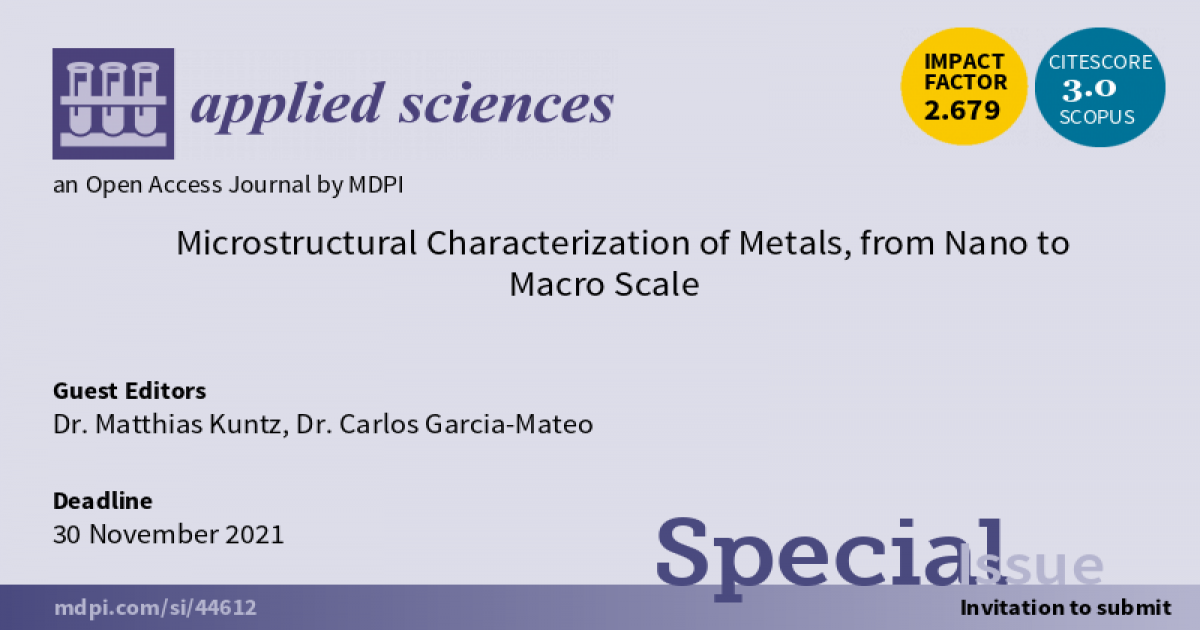Microstructural Characterization of Metals, from Nano to Macro Scale
A special issue of Applied Sciences (ISSN 2076-3417). This special issue belongs to the section "Materials Science and Engineering".
Deadline for manuscript submissions: closed (30 November 2021) | Viewed by 13005

Special Issue Editors
Interests: material characterization; materials; mechanical properties; mechanical behavior of materials; microstructure; fatigue; steel
Special Issues, Collections and Topics in MDPI journals
Interests: steels; steels microstructural characterization; phase transformation in steels; mechanical properties and mechanical behavior of steels
Special Issues, Collections and Topics in MDPI journals
Special Issue Information
Dear Colleagues,
Analyzing and interpreting microstructure is the key to understanding the behavior and mechanism of metallic material. We work on the basis that any improvement, new development, properties of any kind, etc. requires determining, at all scale levels, the characteristics that define the microstructure object of our study.
The future of new manufacturing methods, such as additive manufacturing, or new materials, such as high-entropy alloys, depends on our ability to understand, and characterize at all levels, the new and as yet unknown microstructures that are produced.
The development of new and powerful scientific techniques and equipment (EBSD, APT, HRTEM, Neutron diffraction, Synchrotron radiation, etc.) allows us to obtain fundamental knowledge that helps to establish some of the basic principles that govern the formation of different microstructures.
Other more routine techniques, such as XRD, SEM, TEM, OM, Dilatometry, Calorimetry, EPMA, etc., .also offer valuable information, either used individually or in combination.
This Special Issue on “Microstructural Characterization of Metals, from Nano to Macro Scale” is dedicated to recent advances in research and development of analyzing metallic microstructure.
We invite you to submit research articles or reviews on the latest research work in these areas, with emphasis on applications in all areas of science and engineering.
Dr.-Ing. Matthias KuntzDr. Carlos Garcia-Mateo
Guest Editors
Manuscript Submission Information
Manuscripts should be submitted online at www.mdpi.com by registering and logging in to this website. Once you are registered, click here to go to the submission form. Manuscripts can be submitted until the deadline. All submissions that pass pre-check are peer-reviewed. Accepted papers will be published continuously in the journal (as soon as accepted) and will be listed together on the special issue website. Research articles, review articles as well as short communications are invited. For planned papers, a title and short abstract (about 250 words) can be sent to the Editorial Office for assessment.
Submitted manuscripts should not have been published previously, nor be under consideration for publication elsewhere (except conference proceedings papers). All manuscripts are thoroughly refereed through a single-blind peer-review process. A guide for authors and other relevant information for submission of manuscripts is available on the Instructions for Authors page. Applied Sciences is an international peer-reviewed open access semimonthly journal published by MDPI.
Please visit the Instructions for Authors page before submitting a manuscript. The Article Processing Charge (APC) for publication in this open access journal is 2400 CHF (Swiss Francs). Submitted papers should be well formatted and use good English. Authors may use MDPI's English editing service prior to publication or during author revisions.
Keywords
- metals and alloys
- microstructure
- macrostructure
- nano scale
- characterization techniques
- microscopy diffraction
- microanalysis
- analytical techniques
- nanoindentation
- thermal analysis
Benefits of Publishing in a Special Issue
- Ease of navigation: Grouping papers by topic helps scholars navigate broad scope journals more efficiently.
- Greater discoverability: Special Issues support the reach and impact of scientific research. Articles in Special Issues are more discoverable and cited more frequently.
- Expansion of research network: Special Issues facilitate connections among authors, fostering scientific collaborations.
- External promotion: Articles in Special Issues are often promoted through the journal's social media, increasing their visibility.
- Reprint: MDPI Books provides the opportunity to republish successful Special Issues in book format, both online and in print.
Further information on MDPI's Special Issue policies can be found here.






